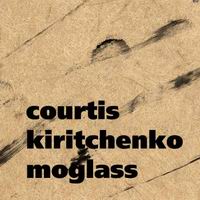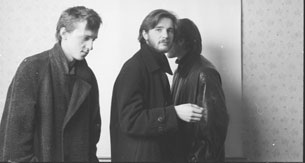
Andrey Kiritchenko/the Moglass/Courtis s/t
[ ns49/CR122/tibCD80/GS#46 / CD ]Collaboration album by Anla Courtis, Andrey Kiritchenko and the Moglass.
Co-released by Carbon Records, Nexsound, Gold Soundz, Tibprod and 1000+1 TiLt
tracklist:
 (1-3) by andrey kiritchenko (sound sources by anla courtis, bandura, objects and field recordings by andrey kiritchenko), by andrey kiritchenko (sound sources by anla courtis, guitar and field recordings by andrey kiritchenko), by andrey kiritchenko (sound sources by anla courtis, guitar and field recordings by andrey kiritchenko)
(1-3) by andrey kiritchenko (sound sources by anla courtis, bandura, objects and field recordings by andrey kiritchenko), by andrey kiritchenko (sound sources by anla courtis, guitar and field recordings by andrey kiritchenko), by andrey kiritchenko (sound sources by anla courtis, guitar and field recordings by andrey kiritchenko) (4-6) by the moglass (sound sources by anla courtis, guitar and synth by the moglass), by the moglass (sound sources by anla courtis, voice, guitar and synth by the moglass), by the moglass (sound sources by anla courtis, voice, guitar and synth by the moglass)
(4-6) by the moglass (sound sources by anla courtis, guitar and synth by the moglass), by the moglass (sound sources by anla courtis, voice, guitar and synth by the moglass), by the moglass (sound sources by anla courtis, voice, guitar and synth by the moglass) (7-11) by anla courtis (sound sources by the moglass), by anla courtis (sound sources by the moglass), by anla courtis (sound sources by the moglass), by anla courtis (sound sources by andrey kiritchenko), by anla courtis (sound sources by andrey kiritchenko)
(7-11) by anla courtis (sound sources by the moglass), by anla courtis (sound sources by the moglass), by anla courtis (sound sources by the moglass), by anla courtis (sound sources by andrey kiritchenko), by anla courtis (sound sources by andrey kiritchenko)
Alan Courtis (a.k.a. Anla Courtis, Alna Courtis, Courtis, etc.) was born in Buenos Aires, Argentina on february 22nd, 1972. He studied classical guitar, piano, theory and composition. He holds a degree in Communication Science from the University of Buenos Aires, where he currently runs an annual music workshop. He played electric guitar in diverse bands and in 1993 he co-founded the group Reynols. With this group he has released more than one hundred CDs and vinyls worldwide in labels like Trente Oiseaux, Digital Narcis, Drone Records, Locust, Sedimental, Beta-Lactam Ring Records, Celebrated Psi Phenomenon, RRR, Audiobot Records, Roaratorio, JDK, Reverse, Matching Head, American Tapes, The Last Visible Dog, Carbon Records, etc.
Andrey Kiritchenko is a person known as an author of projects like Critikal, Sidhartha, NEX(Nihil Est eXcellence), founder and co-runner of Nexsound records, musician who has largely contributed into the development of electronic music scene in Ukraine and already considered as one of the premiere experimental artist from Eastern Europe.
Being involved mostly in experimental electronic and electroacoustic music for the last few years, Andrey is now gaining recognition among the musicians and followers of this style all over the world. His activities range from glitch with blurred beats to electroacoustis experiments, from improv to musique concrete, from drones to microsound.
The group under the Moglass came into being in 1997, preceded by five years of home projects that were never released in public. The Moglass widely used the latest technical achievements of the time such as sampling and postproduction of all kinds, hereat gaining a reputation as post-rock musicians and performing at fashionable discos on repeated occasions. Spellbound with the aesthetics of freeform music, the musicians of the group gradually turned away from glossy sound of their early records and began to decline invitations to fancy discos thus gaining freedom of creating music at home and communicating with a bunch of soul mates scattered all over the world. Up-to-date records of the Moglass are spontaneous improvisations, mostly live records, that by no means always can be called free-noise because sometimes they are very entle and melodic.
